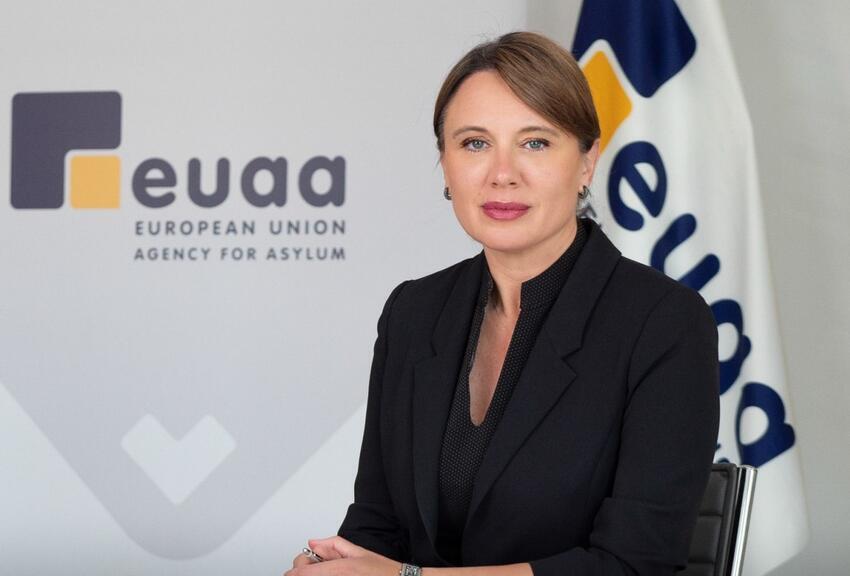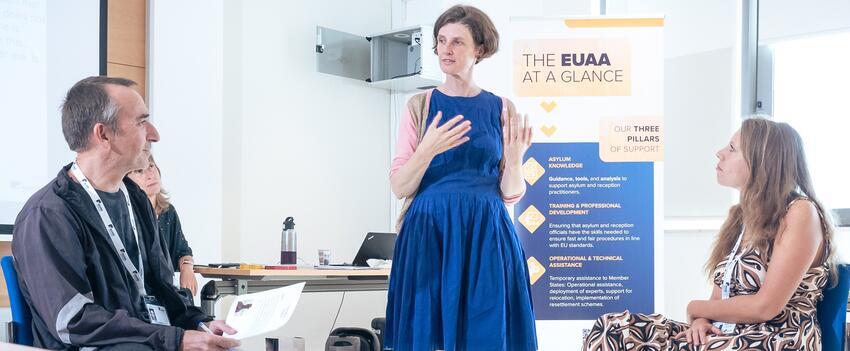> Overview
See key facts and figures on EUAA training in 2022 as well as a focus on the response to the war in Ukraine.
> Training Activities
Here you can find more details about training activities carried out during the year.
> Observations&Trends
This section presents findings about delivery trends and learner feedback.
> EAC
Here you can find key figures and details about the European Asylum Curriculum modules.
Foreword
In January 2022, the European Union Agency for Asylum (EUAA) was established, replacing the European Asylum Support Office. The transformation into an agency with a stronger role in building and implementing the EU’s asylum acquis included a reinforced mandate for training, which had always played an integral part in reaching the objectives of the Agency’s predecessor. One such objective remains to ensure that asylum seekers are welcomed in a dignified manner and that their case is examined following uniform standards, regardless of which Member State is assessing their application. I always strongly believed that EUAA training is one of the principal tools used to promote greater convergence and is a key area of permanent support available to national authorities.
Soon after the launch of the Agency, our capacity to cope with the unexpected was tested to the full. Following the Russian invasion of Ukraine in February 2022, EU+ countries were called upon to find protection solutions for approximately 5 million people fleeing the war – within a very short timeframe.
The Temporary Protection Directive, an already-existing EU legislative tool, provided the framework for a systemic solution. As it had never been activated before, training was vital in enabling Member States to promptly address the needs of persons fleeing Ukraine according to standardised procedures.
Throughout the year, increasing numbers of people sought asylum in the EU and, by the end of 2022, half of EU countries were being providing with operational support by the Agency.

Given the geo-political situation, it can be anticipated that the demand for the Agency’s support will keep growing. The EUAA will continue to deploy innovative training solutions to both address increasing immediate needs, while building the longer-term capacities of national asylum and reception systems.
Nina Gregori
Executive Director of the European Union Agency for Asylum
Throughout 2022, the EUAA continued to develop and deliver vocational training to asylum and reception officials as a key element of the permanent support that the Agency provides to Member States. In parallel, a record number of training sessions were delivered to address immediate capacity building needs in the context of operational support.
This section provides an overview. For more details about the training delivered see the following sections:
- The Training Activities section gives more information about the context of the delivery
- The European Asylum Curriculum section provides more insight into the content delivered
- The Observations and trends section provides a more in-depth look at delivery outcomes

EUAA training in context
Training in the context of permanent support
The EUAA has been mandated to develop a European Asylum Curriculum which EU+ countries should use as a complement to their national training programmes. EUAA training provides a European perspective as all content is based on established common procedures for international protection known as the Common European Asylum System (CEAS).
We use a train-the-trainer system as an effective and efficient way to deliver our training. Once Member State officials have demonstrated that they have the knowledge and skills to deliver sessions as a trainer, they can deliver European Asylum Curriculum modules within their national context. This approach fosters high quality independence of Member State training programmes.
Training under other frameworks
The EUAA delivers training outside the frameworks detailed above. This includes training for its own staff, ad hoc training and training delivered in collaboration with other organisations.
Training in the context of operational support
Capacity building and, notably training, form an integral part of EUAA’s operational support to Member States’ national asylum and reception authorities facing disproportionate pressure from migratory flows. The training is targeted at officials deployed in Member States where the Agency provides operational support. The European Asylum Curriculum constitutes the basis for the Operational Training portfolio with tailor-made training developed to address specific national training needs. On-the-job coaching and other professional development activities are also available.
Training in the context of international cooperation
In addition, training is delivered in countries collaborating with the EUAA under roadmaps and other cooperation agreements as part of the external dimension of the Common European Asylum System.
Training delivered to EU+ countries in 2022
Training delivered in the context of permanent support
Training delivered in the context of operational support
Throughout 2022, increasing numbers of people sought asylum in the EU. EU+ countries received just under 1 million* asylum applications. In addition, around 4 million Ukrainians registered for temporary protection. By the end of the year, half of EU countries had requested operational support.
A key pillar of assistance focused on capacity-building with 12 Member States including a training component in the operational plan.
A total of 4495 learners were trained under the framework of operational training. Many learners participated in several sessions bringing the total number of participations to 8157 which is a 154% increase vs. 2021.
*EU+ countries received some 966 000 asylum applications in 2022, up by around half from 2021 and the most since 2016. You can find out more on the EUAA website - Asylum Trends 2022 Overview

Greece
3109

Spain
1484

Italy
1179

Romania
652

Cyprus
603

Malta
433

Belgium
278

Lithuania
245

Latvia
85

Czech Republic
48

Bulgaria
39

Netherlands
2
Focus on the rapid response to the war in Ukraine
One of the main achievements of 2022 was the timely and efficient way in which the agency responded to the challenges Member States faced due to the high influx of Ukrainians arriving in the EU. It rapidly mobilised support to Member States that were providing protection to people who left Ukraine to seek refuge in the EU. Part of the support included training so that teams on the ground were prepared to deal with the influx of displaced persons.
The training included:
-
Training on the implementation of the Temporary Protection Directive as it had never before been triggered.
-
Training on communication and the provision of information to persons displaced from Ukraine.
Particular focus was placed on communicating with persons who had experienced traumatic events and with children. Sessions were also held on topics such as identifying vulnerable groups including children and potential victims of human trafficking.
The offer was complemented by existing European Asylum Curriculum modules such as the foundation modules or the module on Trafficking in Human Beings.
This is a concrete example of how EUAA training supported a harmonised response to the emergency.

Activation of the Temporary Protection Directive
On 4 March 2022, EU Home Affairs Ministers unanimously agreed to activate the Temporary Protection Directive (Council Directive 2001/55/EC) to ensure the protection needs of millions of people fleeing the Russian invasion of Ukraine. It alleviated pressure on national asylum systems and ensured that people received harmonised rights across the EU, including accommodation, access to the labour market and housing, medical assistance and, in the case of children, access to state education.
The response required a high level of preparedness to meet the needs for training without compromising quality.
“2022 was a year that really tested our capacity to rapidly adapt to a changing environment and develop, as well as implement, new training in response to an emergency situation.
Despite the European Asylum Curriculum being very comprehensive, the topic of Temporary Protection was perhaps only referenced in a few of our modules, without being addressed in detail. The directive had never been activated and as a result, there was no practice, case law or extensive doctrine around the subject.
When the decision to activate the Temporary Protection Directive was taken at EU level, we had to react quickly, so a few colleagues decided to prepare training in case it would be needed. We mainly based it on the EU legal framework and further guidelines from the European Commission. We contacted our Training National Contact Points in late March to let them know this would be available and, for the first training delivered, we received close to 150 expressions of interest. This was a huge surprise, so we had to adapt and increase the number of sessions planned. It also showed how much this training was needed. Throughout the first months after the Russian invasion of Ukraine and TPD activation, we continued to receive different types of requests and managed to capture the key ones in a training package developed for the context of Ukraine.

Carolina Marin, EUAA Trainer involved in development of training content
It was a new situation, involving the cooperation of a number of stakeholders that we had not systematically trained before – including, in some contexts, NGOs. It was a learning experience for us as well, which tested our ability to adapt content to different needs, both in the context of operations and permanent support to EU+ administrations. And, judging from the feedback and interest received throughout the year, I trust that we managed to provide necessary, useful and good quality training products".
As a consequence of the high demand, there was an exponential rise in the number of training sessions delivered. This, of course, impacted the Centre as a whole. The development and provision of specialised training enabled national officials to build capacity quickly whilst dealing with the sudden influx of arrivals. The training was offered to both newly-recruited and existing asylum and reception staff. The tailored training was also available to staff of NGOs mandated by national authorities to provide support. An example is CNRR, the National Romanian Council for Refugees. CNRR is a Bucharest based NGO providing information, counselling and assistance to people fleeing Ukraine, in partnership with the Government and UNHCR. The training organised by EUAA on temporary protection in May, 2022 was the first of its kind CNRR participated in. They subsequently followed additional training sessions.
"The training helped us have a better understanding of both the context in which temporary protection was instituted, its scope and complementarity to the asylum framework, as well as its specific provisions and particularities arising in practice. Taking into account that CNRR’s main activity is legal counselling provision, the training was a valuable tool towards a comprehensive understanding of temporary protection, enabling us to better respond to the information needs of those fleeing the war in Ukraine.

Andreea Ghimpu, Project Coordinator of CNRR (National Romanian Council for Refugees)
Aspects learned in the training further equipped us to improve counselling and awareness raising on the framework, including in relation to public authorities or other NGOs engaged in the humanitarian response. The training had an interactive and practical approach; anticipating and responding to all questions CNRR counsellors had. With limited training opportunities for civil society on the matter, replicating such events is key to improving our capacity to provide adequate support to those in need".

